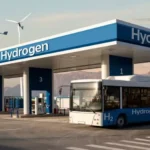Green Hydrogen To Mitigate A Minimum of 50 Million Metric Tonnes Of Greenhouse Gases Annually By 2030

The latest report by WEF in collaboration with Bain & Company outlines the potential, opportunities and roadmap to accelerate the uptake of green hydrogen adoption in India while capitalising on its export potential
India, currently ranked as the world’s third-largest economy in terms of energy needs, is anticipated to experience a 35 per cent surge in energy demand by 2030. To curb the escalating energy import bill, which reached USD185 billion in 2022 and align with its net-zero goals, India aims to achieve a production capacity of 5 million metric tonnes per annum (MMTPA) of green hydrogen by 2030, alongside other energy transition pathways.
To realise this goal, utilising green hydrogen for half of the country’s hydrogen requirements by 2030 could result in a reduction of 50 million metric tons of greenhouse gases and a decreased reliance on energy imports. The latest report, “Green Hydrogen: Enabling Measures Roadmap for Adoption in India,” released by The World Economic Forum(WEF) in collaboration with Bain & Company, outlines the potential, opportunities, and roadmap to accelerate the uptake of green hydrogen adoption in India while capitalising on its export potential.
“With affordable renewable energy, India can attract valuable international trade of green hydrogen derivatives. To boost the country’s export potential, it is crucial to establish recognised standards, improve export infrastructure, and form strategic partnerships. While becoming a leading exporter offers economic advantages, competition is expected with countries like the USA (driven by the Inflation Reduction Act), Australia, Middle East, and South America, owning to their lower production costs.”, said Sachin Kotak, Partner and a leading member of our Energy and Natural Resources practice, Bain and Company.
Green hydrogen is crucial for India’s 2070 net-zero goal, serving the dual purpose of meeting energy security needs and reducing emissions in hard-to-abate sectors. Key measures to expedite the green hydrogen ecosystem include achieving cost-parity with grey hydrogen in production and delivery. On the demand side, it involves supporting industries for green hydrogen consumption in the short term and discouraging carbon-intensive alternatives in the long term.
Currently, green hydrogen production in India costs around USD 4–5/kg, approximately double that of grey hydrogen. To encourage widespread adoption, green hydrogen needs to reach a net price of USD 2/kg or lower. The main cost drivers include round-the-clock renewable energy costs (50 per cent–70 per cent) and electrolyser costs (30 per cent–50 per cent). Storage, constituting 30 per cent–40 per cent of total renewable energy costs, presents a challenge due to the need for steady energy sources, requiring scalable and cost-effective storage systems.
To address these challenges, providing direct subsidies to early adopters, offering incentives and cost waivers on transmission and storage, and supporting the research and development of domestic electrolyser technology are proposed initiatives for scalability. Additionally, creating hydrogen-based industrial clusters and incentivising their formation can accelerate green hydrogen adoption.
On the demand side, industries can be encouraged to consume green hydrogen through targeted incentives, particularly among leading consumers of existing grey hydrogen, such as refineries and ammonia. Direct subsidies can play a crucial role in reducing green hydrogen costs in the short term and driving long-term demand. The next wave of users likely to adopt green hydrogen includes green transportation providers, steel, cement, chemical industries, and power.
In fostering a sustainable future, a dual strategy of incentivising green hydrogen adoption and discouraging carbon-intensive energy sources is deemed critical. This involves redirecting subsidies from high-emission sources while ensuring basic energy needs are met. Collaboration among central and state governments, industry, and academia is emphasised as crucial for India to excel in the global green hydrogen sector, driving necessary changes and innovations in this emerging energy technology.


















































































































































































































































































































































































































































































































































































































































































































































































































































